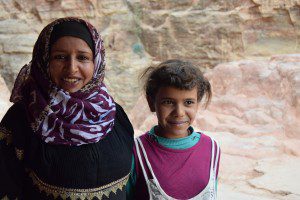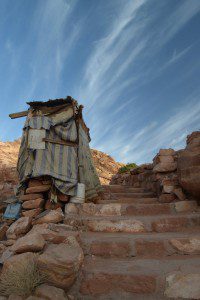They offer tea in cups on small, tin platters and skillful conversation meant to lure you into staying. You can tell what they are  doing and yet it doesn’t seem to matter — you want to stay, and you want to talk. I wanted to buy if I could, because who better to support than rural Bedouin women working a business?
doing and yet it doesn’t seem to matter — you want to stay, and you want to talk. I wanted to buy if I could, because who better to support than rural Bedouin women working a business?
This young girl should have been in school, of course. But her mother was friendly, and not as pushy as some of them were. She smiled and bargained with us — I bought two necklaces from her made of camel bone — one for me, one for my beautiful friend, Nicole
.
The path to The High Place of Sacrifice (I did not know that’s what it was called until after I hiked it) is a steep, challenging climb up ancient stairs carved into the side of the mountain. Our guide, Raed, had force d us to wake up at an ungodly hour, and while I groaned about that wake up call, he was right — the morning was cool and we practically had all of Petra to ourselves.
d us to wake up at an ungodly hour, and while I groaned about that wake up call, he was right — the morning was cool and we practically had all of Petra to ourselves.
As we panted our way up the climb, stopping often for air that suddenly seemed lacking, we’d periodically come across signs of life: small, Bedouin huts that housed tiny treasures that would later be for sale. I was fascinated with the carpets draped over these huts, the designs in them, the fabrics of protection against the desert elements, and the suddenness with which they appeared out of the solitary journey.

I examined the trinkets decorating each hut — a string of Jordanian flags, an embroidered dress, a dirty-faced doll, fabric tied around a tree, its meaning or purpose unknown.


Soon enough we reached the top, a wide and barren place with a breath-stealing view, where a tiny, empty cafe stood listening to the wind, its tin accouterments rattling their contribution to the natural symphony of silence.
W e stayed there, at the top, for a moment. We sat in silent awe, we complained about our screaming legs and our gasping lungs, we took goofy pictures of ourselvesand played chicken with the edge of what seemed to be the universe.
e stayed there, at the top, for a moment. We sat in silent awe, we complained about our screaming legs and our gasping lungs, we took goofy pictures of ourselvesand played chicken with the edge of what seemed to be the universe.
And even here, at the top of nowhere, at the top of this place, there was evidence of civilization as ancient as the sky, far smarter and ingenious than we ever seem to give them credit for.

Finally, we made our way back down the mountain, across the widened canyon and climbed another set of stairs to a large t omb, where more vendors sold their wares.
omb, where more vendors sold their wares.
Here is where I met this woman, who wanted to trade my nose ring for something on her table.
I declined, only because I had no other nose ring with me, and instead I bought some gifts for my Savor Circle — small tin boxes hand decorated with fabric and shiny things. I bought them less because of their beauty than because of hers, though I am fairly certain that after I left, she may have cursed me in Arabic. I’m not sure why, but she seemed mad after I left.

I chose to think it was not about me — or maybe she wanted my nose ring more than I thought?
Either way, I’ve thought — and all these other women — often in the short time since I’ve been back.
We can get so short sighted in our American lives, with our suburban world views and universes that consist of nothing but our PTAs and our busy schedules, our grocery shopping and our meetings for work. Meanwhile, all over the world, other people are having the same experiences, only their work is to give tea to strangers on a mountain path in the desert; their distraction is their lost nose ring; their meetings are with the others who lead the tourists on camel rides.
All our tiny little worlds are so very much the same for their differences. Worlds away, yet right next door.












